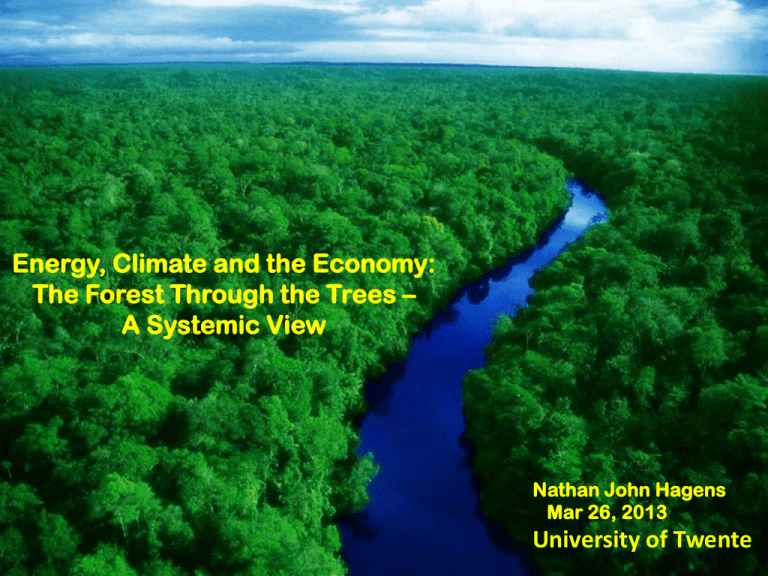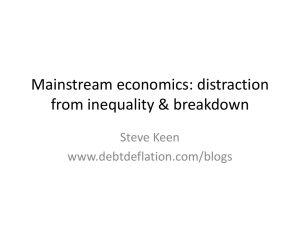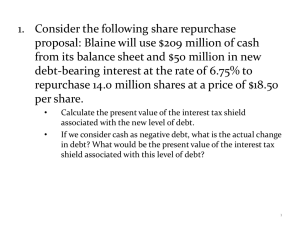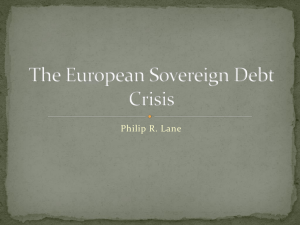A Systematic View (Nathan Hagens)
advertisement

Energy, Climate and the Economy: The Forest Through the Trees – A Systemic View Nathan John Hagens Mar 26, 2013 University of Twente OVERVIEW 1) Energy 2) Economic Growth 3) Debt 4) Implications for climate and policy Part 1: Energy as driver of civilization/living standards Fossil Fuels Solar and labor Available Output Image: Akitu_Northeast Where growth truly comes from 1970-2010 Primary energy conversion efficiency 12%* 2000-2010 Primary energy conversion efficiency 1% Others 14%** Growth in consumption of primary energy 74% Others 3% Growth in consumption of primary energy 96% Sources: BEA, EIA, IEA, World Bank, IIER * Efficiency from primary energy conversions in power production, industrial processes, space heating **Efficiency in other processes, renewable sources, change of accounting standards for GDP/inflation The power lies in the price of energy 180 160 140 5 cents 10 cents 15 cents 20 cents 120 100 80 60 40 20 Energy units replacing human labor 7680 2560 640 320 160 80 40 20 10 0 0 1280 Model assumptions: Initial hourly salary: 3$ Goods prices are fixed, for each doubling of non-human energy inputs, human time is reduced by 40% Salary raise with industrialization (for different prices per energy unit) $/human hour The key dynamic of industrialization is the exchange of human labor for a relatively large amount of lowcost energy Benefits are significant, but disappear quickly with rising energy prices. Yellow line: non-OPEC average cash production cost. Blue line: marginal cost of production Source: Production data from Gregor.us (EIA), cost data from Bernstein, 2012 Exhibit 12 Part 2: Debt as spatial and temporal reallocator of scarce resources What is money? A simple way to put it is to say it represents “the power to buy a certain amount of energy” It is a marker for time spent by humans and/ or energy embodied in goods and services. Money is a claim on future natural resources What is debt? Traditional economics see debt as a simple transfer of consumption from person A to person B. In reality it represents a shift in time and/or location. Debt is a claim on future money. Credit: First a blessing, then a curse In contrast to most macroeconomic views, credit is not neutral to an economy A family (or country) with ever-growing debt… Money available for consumption 200 Bank says: no further credit! 150 100 50 0 -50 Income New credit Credit payments Net income -100 Year 1 Year 2 Year 3 Year 4 Year 5 Year 6 Year 7 Debt growth outpaces the economy *Sources: U.S. Federal Reserve – Flow of Funds, U.S. Bureau of Economic Analysis U.S. debt and GDP growth* 60 50 Total public and private debt in 2005$ 40 GDP in 2005$ 30 20 10 0 1952 1956 1960 1964 1968 1972 1976 1980 1984 1988 1992 1996 2000 2004 2008 US$ trillion For the past 50 years, debt levels have been growing faster than economic output (GDP) for the U.S. in every year except 1966, and similarly in all other OECD countries. Our models suggest that credit growing faster than GDP is unsustainable, eventually leading to instability. How many GDP$ for each $ of new debt? Debt sustainability acts as a measure of the long-term viability of debt and compares economic growth vs. (non-financial) credit volume growth 1.20 1.00 minimum requirement for long term sustainable credit growth 0.80 0.60 Brazil, India Europe China 0.40 0.20 actual debt sustainability minimum Private and public sector debt growth (without financial sector) Sources: U.S. Federal Reserve, BEA, IIER calculations 2010 2008 2006 2004 2002 2000 1998 1996 1994 1992 1990 1988 1986 1984 1982 1980 1978 1976 1974 1972 1970 1968 1966 1964 1962 1960 1958 1956 - 1954 GDP growth per $ of new non-financial debt (nominal) U.S. sustainability of new debt (3-year moving average) Synthesis General trends over longer periods Physical world expansion Debt creation Globalization Stagnation (and decline) 1750-2000 1980-2008 1980-2008 2008- Industrialization bringing access to more and cheaper resources Fast growth of credit allowed a further expansion Allocation of effort to place of lowest effort Last attempt of debtdriven expansion with low debt productivity Led to more wealth for everybody in advanced economies Led to high asset value gains and high returns Allowed to continue consumption and grew emerging economies Keeps status up, but introduces significant volatility Is limited by reduced marginal returns and higher extraction cost Is limited by absolute debt limits and rising default risk Is limited by the lack of further large outsourcing destinations Is limited by fewer and fewer creditworthy borrowers «Warren Buffet» Age Corporate/Emerging Economy Age Government Age The world is trapped from two sides Higher levels of debt will demand higher returns, with interest expectations rising further along with economic uncertainty Economies will neither be able to grow debt further nor serve existing debt Unresolved Gap Economic growth becomes almost impossible due to re-source limitations Growth from applying more low cost energy and resources is no longer possible due to higher (extraction) cost, and further burdened by expensive renewables and increased cost of environmental protection measures Most policy-makers expect growth The predominant expectation is that the current problems are temporary and that growth will resume No large government or policy-making institution evaluates scenarios that involve long-term stagnation or decline *Sources: U.S. Congressional Budget Office, IIER Source; IIER research, “Green Growth- An Oxymoron?” Nov 2011 2013 GDP 2014 GDP Energy/Capita vs. % Very Happy – (worldvaluesurvey.org) Conclusions 1) The primary drivers of growth – cheap energy and available credit are waning. 2) We don’t face a resource scarcity situation but one of ‘resource contribution’ 3) If OECD growth is over, paradoxically we may have an extended period of ‘energy surplus’ while other inputs become more limiting. 4) Some portion of resources (human, financial, energy) preparing for a lower carbon future need to integrate/plan for a lower consumption future. Some Relevant Questions • What is the carbon footprint of central bank printing/support? • What is the decline rate for oil production (and renewable buildout etc) WITHOUT central bank support? • What are we trying to optimize? • Given energy/economic constraints, can 3C+ be avoided under capitalism/democracy? • What can we do? As a world? As individual nations? As communities? As individuals?








